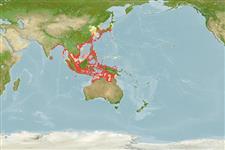Common names from other countries
Environment: milieu / climate zone / depth range / distribution range
Ecologia
marinhas; Água doce; estuarina; anfídromo (Ref. 51243); intervalo de profundidade 0 - 50 m (Ref. 189). Tropical; 42°N - 17°S, 81°E - 147°E (Ref. 189)
Eastern Indian Ocean: northern and eastern Bay of Bengal coasts, including the Andaman Islands; perhaps southward from the Godavari river. Western Pacific: northern coast of Australia, Arafura Sea (Ref. 9819), Gulf of Papua, Sarawak, presumably the Philippines and Hong Kong; China from Taiwan north to Yellow Sea and southern part of Sea of Japan.
Tamanho / Peso / Idade
Maturity: Lm ? range ? - ? cm
Max length : 22.0 cm SL macho/indeterminado; (Ref. 9822); peso máx. Publicado: 44.25 g (Ref. 124713)
Espinhos dorsais (total): 0; Espinhos anais 0; Raios anais moles: 46 - 56. Belly with 18 to 20 (rarely 17 or 21) + 7 (sometimes 8) = 25 to 27 keeled scutes from isthmus to anus. Lower gill rakers with the serrae uneven, with slight or sometimes distinct clumps of larger serrae. Pectoral filament moderate, reaching back to base of 9th to 21st anal fin ray.
Presumably schooling and occurring mostly in coastal waters, but also entering estuaries (Ref. 11230) (e.g. the Hooghly and Godavari in India) and penetrating at least 20 km up the Godavari, tolerating salinities as low as 8.7 ppt. Feeds on prawn, copepods, crustacean larvae, mollusks and fishes. Fairly common (Ref. 189).
Life cycle and mating behavior
Maturidade | Reprodução | Desova | Ovos | Fecundidade | Larvas
Wongratana, T., T.A. Munroe and M. Nizinski, 1999. Order Clupeiformes. Engraulidae. Anchovies. p. 1698-1753. In K.E. Carpenter and V.H. Niem (eds.) FAO species identification guide for fishery purposes. The living marine resources of the WCP. Vol. 3. Batoid fishes, chimaeras and bony fishes part 1 (Elopidae to Linophrynidae). FAO, Rome. (Ref. 9822)
Categoria na Lista Vermelha da IUCN (Ref. 130435)
CITES (Ref. 128078)
Not Evaluated
Ameaça para o homem
Harmless
Utilização humana
Pescarias: pouco comercial
Mais informação
Nomes comunsSinónimosMetabolismoPredadoresEcotoxicologiaReproduçãoMaturidadeDesovaFecundidadeOvosDesenvolvimento dos ovos
ReferênciasAquaculturaPerfil para aquaculturaEstirpesGenéticaElectrophoresesHereditariedadeDoençasProcessamentoMass conversion
ColaboradoresFotografiasStamps, Coins Misc.SonsCiguateraVelocidadeTipo de nataçãoÁrea branquialOutras referênciasCérebrosVisão
Ferramentas
Relatórios especiais
Descarregue XML
Fontes da internet
Estimates based on models
Preferred temperature (Ref.
115969): 24.7 - 29.1, mean 28.4 (based on 948 cells).
Phylogenetic diversity index (Ref.
82804): PD
50 = 0.5039 [Uniqueness, from 0.5 = low to 2.0 = high].
Bayesian length-weight: a=0.00447 (0.00265 - 0.00754), b=3.10 (2.96 - 3.24), in cm Total Length, based on LWR estimates for this species & (Sub)family-body (Ref.
93245).
Nível Trófico (Ref.
69278): 3.6 ±0.51 se; based on food items.
Resiliência (Ref.
120179): Elevada, tempo mínimo de duplicação da população menor que 15 meses (Preliminary K or Fecundity.).
Fishing Vulnerability (Ref.
59153): Low vulnerability (17 of 100).
